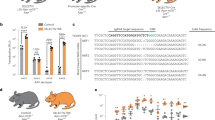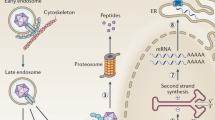Abstract
A major obstacle limiting gene therapy for diseases of the heart and skeletal muscles is an inability to deliver genes systemically to muscles of an adult organism. Systemic gene transfer to striated muscles is hampered by the vascular endothelium, which represents a barrier to distribution of vectors via the circulation. Here we show the first evidence of widespread transduction of both cardiac and skeletal muscles in an adult mammal, after a single intravenous administration of recombinant adeno-associated virus pseudotype 6 vectors. The inclusion of vascular endothelium growth factor/vascular permeability factor, to achieve acute permeabilization of the peripheral microvasculature, enhanced tissue transduction at lower vector doses. This technique enabled widespread muscle-specific expression of a functional micro-dystrophin in the skeletal muscles of dystrophin-deficient mdx mice, which model Duchenne muscular dystrophy. We propose that these methods may be applicable for systemic delivery of a wide variety of genes to the striated muscles of adult mammals.
This is a preview of subscription content, access via your institution
Access options
Subscribe to this journal
Receive 12 print issues and online access
$209.00 per year
only $17.42 per issue
Buy this article
- Purchase on Springer Link
- Instant access to full article PDF
Prices may be subject to local taxes which are calculated during checkout






Similar content being viewed by others
References
Hoshijima, M. et al. Chronic suppression of heart-failure progression by a pseudophosphorylated mutant of phospholamban via in vivo cardiac rAAV gene delivery. Nat. Med. 8, 864–871 (2002).
Musaro, A. et al. Localized Igf-1 transgene expression sustains hypertrophy and regeneration in senescent skeletal muscle. Nat. Genet. 27, 195–200 (2001).
Harper, S.Q. et al. Modular flexibility of dystrophin: implications for gene therapy of Duchenne muscular dystrophy. Nat. Med. 8, 253–261 (2002).
Greelish, J.P. et al. Stable restoration of the sarcoglycan complex in dystrophic muscle perfused with histamine and a recombinant adeno-associated viral vector. Nat. Med. 5, 439–443 (1999).
Bridges, C.R. et al. Global cardiac-specific transgene expression using cardiopulmonary bypass with cardiac isolation. Ann. Thorac. Surg. 73, 1939–1946 (2002).
Huard, J. et al. The route of administration is a major determinant of the transduction efficiency of rat tissues by adenoviral recombinants. Gene Ther. 2, 107–115 (1995).
Cho, W.K. et al. Modulation of Starling forces and muscle fiber maturity permits adenovirus-mediated gene transfer to adult dystrophic (mdx) mice by the intravascular route. Hum. Gene Ther. 11, 701–714 (2000).
Zhang, G., Budker, V., Williams, P., Hanson, K. & Wolff, J.A. Surgical procedures for intravascular delivery of plasmid DNA to organs. Methods Enzymol. 346, 125–133 (2002).
Dellorusso, C. et al. Functional correction of adult mdx mouse muscle using gutted adenoviral vectors expressing full-length dystrophin. Proc. Natl. Acad. Sci. USA 99, 12979–12984 (2002).
Watchko, J. et al. Adeno-associated virus vector-mediated minidystrophin gene therapy improves dystrophic muscle contractile function in mdx mice. Hum. Gene Ther. 13, 1451–1460 (2002).
Halbert, C.L., Rutledge, E.A., Allen, J.M., Russell, D.W. & Miller, A.D. Repeat transduction in the mouse lung by using adeno-associated virus vectors with different serotypes. J. Virol. 74, 1524–1532 (2000).
Scott, J.M. et al. Viral vectors for gene transfer of micro-, mini-, or full-length dystrophin. Neuromuscul. Disord. 12, S23–S29 (2002).
Roberts, W.G. & Palade, G.E. Increased microvascular permeability and endothelial fenestration induced by vascular endothelial growth factor. J. Cell Sci. 108, 2369–2379 (1995).
Senger, D.R., Perruzzi, C.A., Feder, J. & Dvorak, H.F. A highly conserved vascular permeability factor secreted by a variety of human and rodent tumor cell lines. Cancer Res. 46, 5629–5632 (1986).
Hauser, M.A. et al. Analysis of muscle creatine kinase regulatory elements in recombinant adenoviral vectors. Mol. Ther. 2, 16–25 (2000).
Hartigan-O'Connor, D., Kirk, C.J., Crawford, R., Mule, J.J. & Chamberlain, J.S. Immune evasion by muscle-specific gene expression in dystrophic muscle. Mol. Ther. 4, 525–533 (2001).
Grimm, D. et al. Preclinical in vivo evaluation of pseudotyped adeno-associated virus vectors for liver gene therapy. Blood 102, 2412–2419 (2003).
Yuasa, K. et al. Adeno-associated virus vector-mediated gene transfer into dystrophin-deficient skeletal muscles evokes enhanced immune response against the transgene product. Gene Ther. 9, 1576–1588 (2002).
Pinson, K.I., Dunbar, L., Samuelson, L. & Gumucio, D.L. Targeted disruption of the mouse villin gene does not impair the morphogenesis of microvilli. Dev. Dyn. 211, 109–121 (1998).
Petrof, B.J., Shrager, J.B., Stedman, H.H., Kelly, A.M. & Sweeney, H.L. Dystrophin protects the sarcolemma from stresses developed during muscle contraction. Proc. Natl. Acad. Sci. USA 90, 3710–3714 (1993).
Gregorevic, P. & Chamberlain, J.S. Gene therapy for muscular dystrophy - a review of promising progress. Expert Opin. Biol. Ther. 3, 803–814 (2003).
Sakamoto, M. et al. Micro-dystrophin cDNA ameliorates dystrophic phenotypes when introduced into mdx mice as a transgene. Biochem. Biophys. Res. Commun. 293, 1265–1272 (2002).
Ahmad, A., Brinson, M., Hodges, B.L., Chamberlain, J.S. & Amalfitano, A. Mdx mice inducibly expressing dystrophin provide insights into the potential of gene therapy for Duchenne muscular dystrophy. Hum. Mol. Genet. 9, 2507–2515 (2000).
Phelps, S.F. et al. Expression of full-length and truncated dystrophin mini-genes in transgenic mdx mice. Hum. Mol. Genet. 4, 1251–1258 (1995).
Arruda, V.R. et al. Lack of germline transmission of vector sequences following systemic administration of recombinant AAV-2 vector in males. Mol. Ther. 4, 586–592 (2001).
Herzog, R.W. et al. Influence of vector dose on factor IX-specific T and B cell responses in muscle-directed gene therapy. Hum. Gene Ther. 13, 1281–1291 (2002).
Manno, C.S. et al. AAV-mediated factor IX gene transfer to skeletal muscle in patients with severe hemophilia B. Blood 101, 2963–2972 (2003).
Eppler, S.M. et al. A target-mediated model to describe the pharmacokinetics and hemodynamic effects of recombinant human vascular endothelial growth factor in humans. Clin. Pharmacol. Ther. 72, 20–32 (2002).
Herzog, R.W. et al. Long-term correction of canine hemophilia B by gene transfer of blood coagulation factor IX mediated by adeno-associated viral vector. Nat. Med. 5, 56–63 (1999).
Rutledge, E.A., Halbert, C.L. & Russell, D.W. Infectious clones and vectors derived from adeno-associated virus (AAV) serotypes other than AAV type 2. J. Virol. 72, 309–319 (1998).
Grimm, D., Kern, A., Rittner, K. & Kleinschmidt, J.A. Novel tools for production and purification of recombinant adeno-associated virus vectors. Hum. Gene Ther. 9, 2745–2760 (1998).
Halbert, C.L., Allen, J.M. & Miller, A.D. Adeno-associated virus type 6 (AAV6) vectors mediate efficient transduction of airway epithelial cells in mouse lungs compared to that of AAV2 vectors. J. Virol. 75, 6615–6624 (2001).
Rafael, J.A. et al. Forced expression of dystrophin deletion constructs reveals structure-function correlations. J. Cell Biol. 134, 93–102 (1996).
Acknowledgements
We thank S.D. Hauschka for helpful discussions; D. Duan for the AAV MCS vector plasmids pDD2 and pDD344; J. Kleinschmidt for the packaging plasmid pDG; A.D. Miller for the packaging cell line 293; J. Han for the rAAV6–CK6–lacZ construct; and M. Haraguchi and S. Oakley for technical assistance. This work was supported by grants from the National Institutes of Health and the Muscular Dystrophy Association (USA) to J.S.C.
Author information
Authors and Affiliations
Corresponding author
Ethics declarations
Competing interests
The University of Washington, which employs the authors, has filed for a patent application relating to some of the results reported in this manuscript.
Supplementary information
Supplementary Fig. 1
Intravenous administration of rAAV6 vectors and VEGF is not associated with evidence of acute organ toxicity. (PDF 389 kb)
Rights and permissions
About this article
Cite this article
Gregorevic, P., Blankinship, M., Allen, J. et al. Systemic delivery of genes to striated muscles using adeno-associated viral vectors. Nat Med 10, 828–834 (2004). https://doi.org/10.1038/nm1085
Received:
Accepted:
Published:
Issue Date:
DOI: https://doi.org/10.1038/nm1085
This article is cited by
-
Generation and optimization of off-the-shelf immunotherapeutics targeting TCR-Vβ2+ T cell malignancy
Nature Communications (2024)
-
Screening for gene doping transgenes in horses via the use of massively parallel sequencing
Gene Therapy (2022)
-
TAZ links exercise to mitochondrial biogenesis via mitochondrial transcription factor A
Nature Communications (2022)
-
Suppression of heterotopic ossification in fibrodysplasia ossificans progressiva using AAV gene delivery
Nature Communications (2022)
-
Yap regulates skeletal muscle fatty acid oxidation and adiposity in metabolic disease
Nature Communications (2021)



